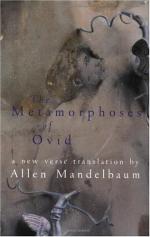|
This section contains 355 words (approx. 1 page at 400 words per page) |

|
Metamorphoses Summary & Study Guide Description
Metamorphoses Summary & Study Guide includes comprehensive information and analysis to help you understand the book. This study guide contains the following sections:
This detailed literature summary also contains Bibliography on Metamorphoses by Ovid.
Ovid is, after Homer, the single most important source for classical mythology. The Metamorphoses, which he wrote over the six-year period leading up to his exile from Rome in 8 a.d. , is the primary source for over two hundred classical legends that survived to the twenty-first century. Many of the most familiar classical myths, including the stories of Apollo and Daphne and Pyramus and Thisbe, come directly from Ovid.
The Metamorphoses is a twelve-thousand-line poem, written in dactylic hexameters and arranged loosely in chronological order from the beginning of the universe's creation to the Augustan Rome of Ovid's own time. The major theme of the Metamorphoses, as the title suggests, is metamorphosis, or change. Throughout the fifteen books making up the Metamorphoses, the idea of change is pervasive. Gods are continually transforming their own selves and shapes, as well as the shapes and beings of humans. The theme of power is also ever-present in Ovid's work. The gods as depicted by the Roman poets are wrathful, vengeful, capricious creatures who are forever turning their powers against weaker mortals and half-mortals, especially females. Ovid's own situation as a poet who was exiled because of Augustus's capriciousness is thought by many to be reflected in his depictions of the relationships between the gods and humans.
It can be argued with a great deal of justification that the Metamorphoses is Western literature and art's most influential work. Ovid was hugely popular during his lifetime, and the influence of his work continued to grow immediately after his death. Writers as diverse as Dante, Shakespeare, Christopher Marlowe, and Ted Hughes have drawn on the Metamorphoses for inspiration. Artists throughout the centuries have depicted scenes from Ovid's work in their own paintings. The list of writers, poets, artists, musicians, and performers who have been directly influenced by the Metamorphoses is extensive and covers virtually every era since Ovid's death in 17 a.d. Many English translations of the work, in both prose and verse, exist, giving further evidence of the poem's lasting significance.
The discussion in the Plot Summary, Themes, and Style sections below focuses on Book 1 of the Metamorphoses.
Read more from the Study Guide
|
This section contains 355 words (approx. 1 page at 400 words per page) |

|



